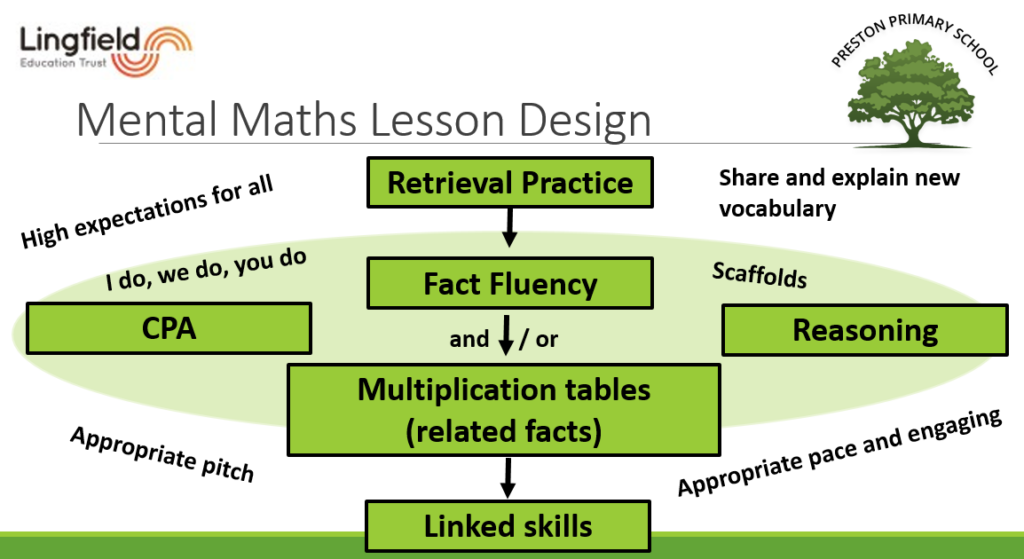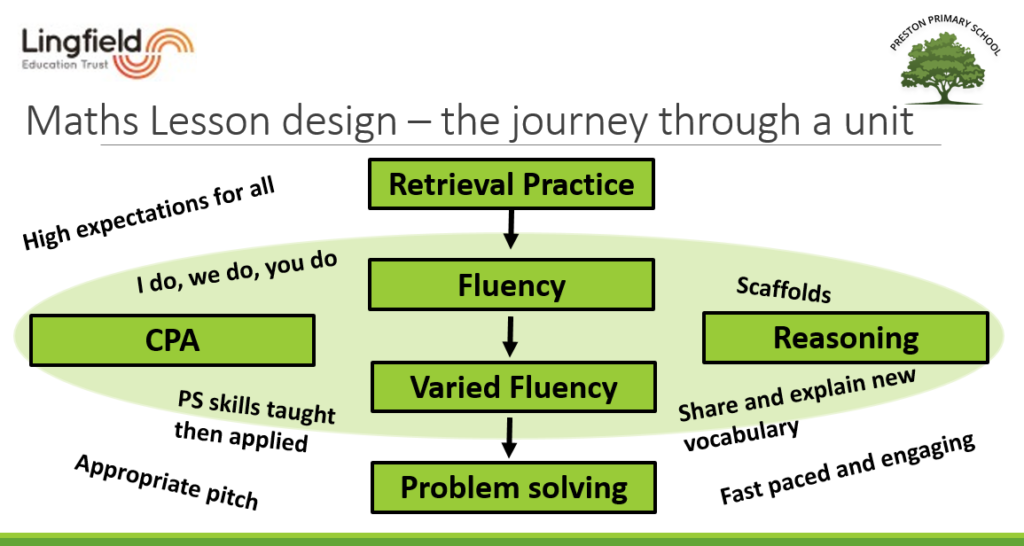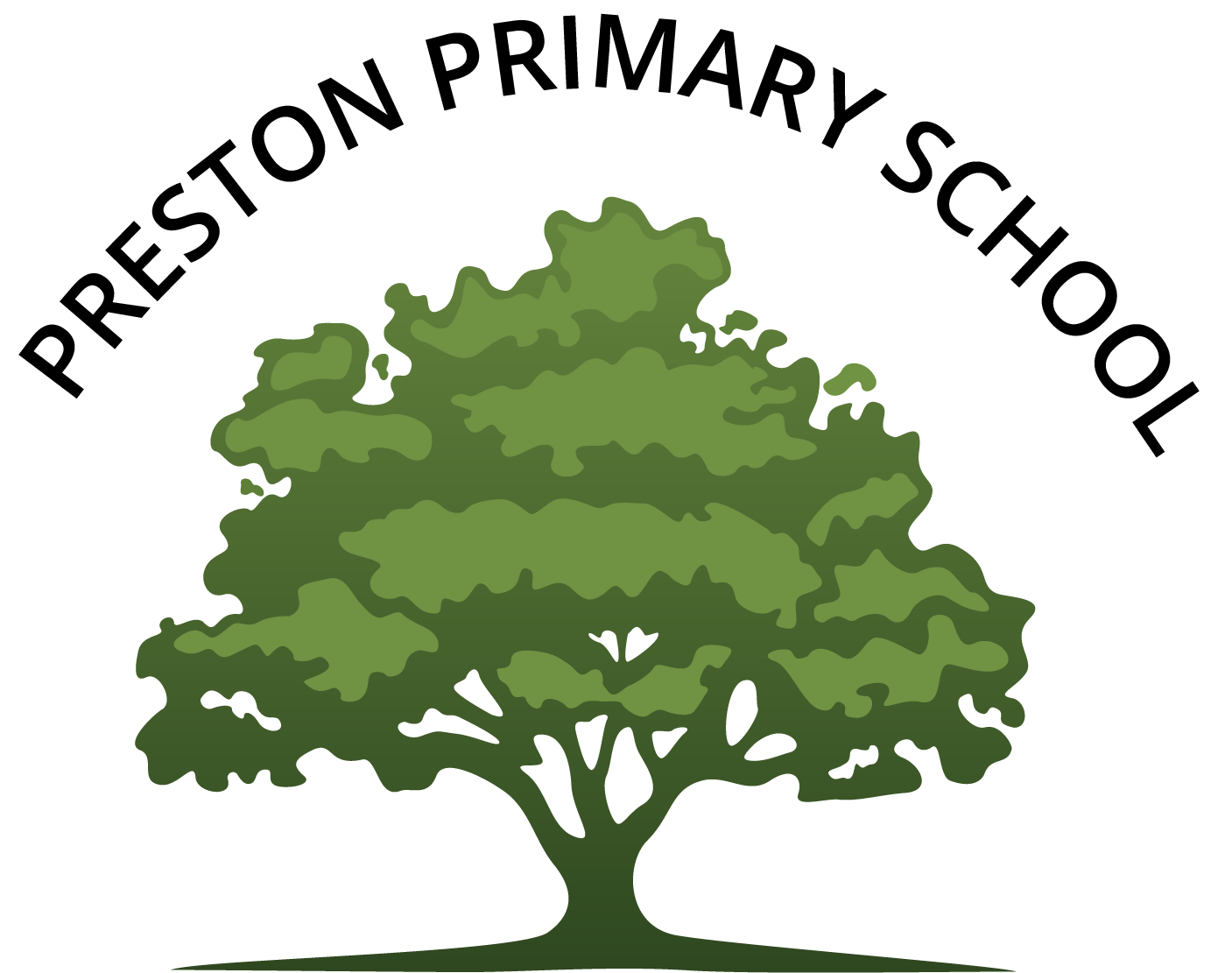Maths
| Teaching mathematics At Preston Primary, our intent is to give the pupils a progressive, thoughtfully sequenced maths learning experience that enables them to: • become confident numerate citizens • talk confidently and reason about maths • apply their maths learning to real-life, everyday contexts • reach the expected standards at EYFS, Key Stages 1 and 2 – and, where possible, exceed expectations in Key Stages 1 and 2 • gain a passion for maths Through a carefully sequenced, inter-connected and progressive maths curriculum and using clear explanations and modelling, we aim to develop in pupils a deep understanding of the relative size of numbers (at age appropriate levels) and the ability to move fluently between operations and representations with increasing confidence. We want the pupils, above all, to become confident, ‘numerate’ mathematicians. |
Overarching principles
At Preston, through our daily maths lessons, we teach units of work through a concrete (using manipulatives/objects) – pictorial (visual representations) – abstract approach. We focus on developing fluency, leading to varied fluency, leading to application, to problem solving, reasoning and justification. Through clear explanations, effective scaffolding and modelling of maths concepts, pupils are given the best chance to make good progress.
When new maths units are introduced, prior learning that the new content is to be built on will be revisited and revised at the beginning of the unit of work to ensure a firm foundation and a progressive journey through the unit. Teachers are expected to draw links from prior learning throughout their teaching and this is to encourage what we, at Preston, call ‘sticky’ learning’ (ie. facts, knowledge and concepts that are retained and ultimately not forgotten). This is predominantly done as quick lesson starters with the focus being on content from the previous day, week, month or even term. We strongly feel that this encourages ‘sticky learning ‘. Regular, deliberate practice is given to support fluency and retention.
At Preston, we greatly value the notion of ‘incidental teaching’ – that is to say taking apt opportunities to ‘drip-feed back in’ previous learning. Class teachers determine how and when these opportunities are used. Pupils are taught that there is often more than one way to solve a maths problem and that having a try, playing with numbers and gaining a sense of an ‘appropriate answer’ are key qualities of a mathematician. We aim for children to enjoy and engage in their maths learning – rather than see mathematics as a ‘memory test’.
Teachers do not teach objectives relating to the school year above – rather, they ‘go deeper and wider’ within the year group objectives being taught (see Greater Depth/Mastery statement).
Early Years
For 2020-21, Preston was an Early Years Adopter School. Our teaching of number promotes a deep understanding of number to 10, including the composition of each number. Pupils are taught to subitise (recognise quantities without counting) up to 5, automatically recall number bonds up to at least 5 (including subtraction facts).
In the teaching of numerical patterns, pupils are taught to count beyond 20, recognise the pattern of the counting system and compare quantities up to 10 in different contexts. In addition, pupils explore and represent patterns within 10, including evens and odds and double facts.
We believe it is important that the curriculum includes rich opportunities for children to develop their spatial reasoning skills across all areas of mathematics including shape, space and measures.
It is important that children develop positive attitudes and interests in mathematics, look for patterns and relationships, spot connections, ‘have a go’, talk to adults and peers about what they notice and not be afraid to make mistakes. Children are given opportunities to explore and develop mathematical concepts both in the classroom and outdoors using a range of practical apparatus.
Key Stage 1
In Key Stage 1, practical resources continue to be used to support pupils’ learning. Children are introduced to different ways of recording their work, initially through informal jottings then (when appropriate) via more structured calculations.
Pupils are taught to develop confidence in mental fluency, counting and place value – including working with numerals, words and the 4 operations. Children regularly count forwards and backwards on a number line or number square – initially in steps of 1 – then gradually progressing to steps of 2, 5, 10 and 3. Mental agility is further tested as the children learn their number bonds – firstly up to 10 (e.g. 2 + ? = 10, 4 + ? =10 etc.) and then to 20.
Pupils are taught to sort different shapes and use the related vocabulary and to use a range of measures to describe and compare different quantities such as length, mass, capacity/volume, time and money.
Key mathematics related vocabulary is reinforced and regularly used in an incidental context to aid pupils’ retention. This supports pupils’ ability to begin reasoning about their maths work.
Children learn their x2, x3, x5 and x10 tables and begin to see the link with division (inverses).
Key Stage 2 Maths
In Key Stage 2, there is a continued emphasis on pupils becoming increasingly efficient, fluent and accurate in their arithmetic/calculations related work as well as more confident in their ability to reason and talk about their maths thinking in general.
Pupils learn how to solve more complex, multi stepped problems, to estimate and to reason and justify (often through open questions such as ‘why?’, ‘what if?’, ‘always/sometimes or never?’ etc)
Practical resources continue to be used throughout Key Stage 2 to support children’s thinking as appropriate (ie. counting sticks, tens frames, Dienes cubes, coins and other concrete objects/ manipulatives).
Pupils are taught to understand the close links between addition and subtraction as well as between multiplication and division. When learning tables by heart, pupils are expected to know the corresponding division facts (eg: 7 x 4 = 28 so 28 ÷ 7 = 4 and 28 ÷ 4 = 7 etc).
By the end of Year 4, tables facts to 12 x 12 are expected to have been learnt.
By the end of Key Stage 2, we aim to ensure that pupils extend their understanding of the number system and place value to include larger integers. We teach pupils to see connections between fractions, decimals, percentages and ratio. Pupils are introduced to algebra and increasingly complex properties of numbers.
______________________________________________________________________________
Throughout school, through high quality teaching and learning, pupils are expected to master the curriculum content for their respective year groups. Some pupils will go on to achieve greater depth in maths – see Greater Depth/Mastery statement (on website) for details of this.
The school has an agreed progression document for each of the 4 rules number operations (see website). Parents are informed of these methods at a curriculum parents’ evening and parents are referred to the school’s website for details.
Planned, regular and targeted maths CPD allows staff to have the confidence and skills needed to deliver a rich, progressive maths curriculum.
How we teach maths


Long Term Framework
Helping at home – some useful documents
Useful weblinks:
https://whiterosemaths.com/
https://classroom.thenational.academy/
https://home.oxfordowl.co.uk/kids-activities/fun-maths-games-and-activities/



